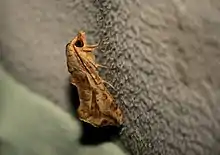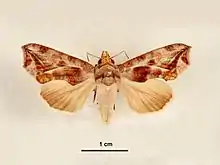Oraesia emarginata
Oraesia emarginata is a species of moth of the family Erebidae first described by Johan Christian Fabricius in 1794. It is found in Australia, New Caledonia, Indonesia, New Guinea, Pakistan, the Philippines, India, Sri Lanka, Sulawesi, Taiwan, China, Japan, Korea and Nepal as well as Eritrea, Ethiopia, Kenya, Namibia, Nigeria, South Africa, Tanzania, the Gambia, Uganda, Oman and Yemen.[1]
| Oraesia emarginata | |
|---|---|
 | |
| Scientific classification | |
| Kingdom: | Animalia |
| Phylum: | Arthropoda |
| Class: | Insecta |
| Order: | Lepidoptera |
| Superfamily: | Noctuoidea |
| Family: | Erebidae |
| Genus: | Oraesia |
| Species: | O. emarginata |
| Binomial name | |
| Oraesia emarginata (Fabricius, 1794) | |
| Synonyms | |
| |
Description
The wingspan is about 35–42 mm. Antennae of male unipectinate. Palpi with the third joint produced to a point. Forewings with outer margin angled at vein 4. Male has fiery orange head and collar. Thorax reddish brown. Abdomen fuscous. Forewings reddish brown suffused with purple. Numerous indistinct slightly waved oblique lines present. A dark streak found on median nervure. An oblique double line runs from apex to inner margin beyond middle, filled in with pale near apex. The area beyond it suffused with gold colour. Hindwings ochreous white, suffused with fuscous towards outer margin.[2]
Female has much more variegated forewings. A diffused chocolate patch found below middle of cell. A white streak can be seen on vein 2. Abdomen and hindwings fuscous. Larva dark violet brown with a sub-dorsal series of scarlet and yellow spots and sub-lateral white dot series. They pierce fruit (peach, loquat and citrus) to suck the juice.[3]
The larvae feed on Menispermaceae species, including Stephania japonica as well as Cissampelos and Cocculus species. This species overwinters in the larval stage in clusters of weeds and soil cracks around the host plant.[4] Some other food plants are Citrus, Dimocarpus, Ipomoea, Malus pumila, Merremia quinquefolia, Prunus persica, Psidium guajava, Sida, Stephania discolor, Vitis, and Ardenia gummifera.[5]
Subspecies
- Oraesia emarginata emarginata
- Oraesia emarginata defreinai Behounek, Hacker & Speidel, 2010 (Ethiopia, Kenya, Namibia, Nigeria, Oman, South Africa, Tanzania and Yemen)
Gallery
 Female, dorsal view
Female, dorsal view Male, dorsal view
Male, dorsal view Female, ventral view
Female, ventral view Male, ventral view
Male, ventral view Larva
Larva
References
- De Prins, J. & De Prins, W. (2018). "Oraesia emarginata (Fabricius, 1794)". Afromoths. Retrieved 21 January 2019.
- Hampson, G. F. (1894). The Fauna of British India, Including Ceylon and Burma: Moths Volume II. Taylor and Francis – via Biodiversity Heritage Library.
- Holloway, Jeremy Daniel. "Oraesia emarginata Fabricius". The Moths of Borneo. Retrieved 18 August 2016.
- Herbison-Evans, Don & Crossley, Stella (7 August 2015). "Oraesia emarginata (Fabricius, 1794) Fruit Piercing Moth". Australian Caterpillars and their Butterflies and Moths. Retrieved 21 January 2019.
- "Oraesia emarginata (Fabricius, 1794)". African Moths. Retrieved 18 August 2016.
External links
- Morphology, life history and circadian rhythm of the fruit-piercing moth, Oraesia emarginata (Lepidoptera: Noctuidae)
- Bionomics, ecology and control methods of fruit-piercing moths, Oraesia emarginata Fabricius and Oraesia excavata Butler
- Pherobase Invasive
- Mating, feeding and flight behaviors of the Fruit Sucking Moth, Oraesia emarginata